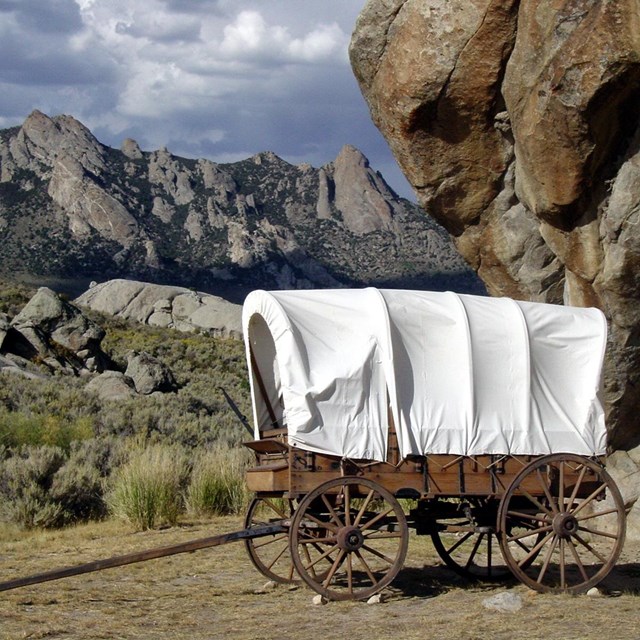Last updated: December 20, 2021
Article
Christmas on the Emigrant Trails: Christmas 1849 at Bruff’s Camp, California
Most emigrants reached the end of their long overland journey weeks or months before December 25 rolled around. A few, though, stranded or lost along the way, spent their first Christmas in the West in winter camps many miles from the settlements. Here’s how they observed the holiday.

Image/Public Domain
Three years after the Donner-Reed Christmas experience in 1846, on the Lassen branch of the California Trail, ‘49er J. Goldsborough Bruff celebrated a rustic but more pleasant Christmas in the Cascades Mountains, north of the Sierra Nevada. Bruff, a professional draftsman and a strong-willed individual, ended up stuck in the mountains at Christmas largely due to his own pride and stubbornness. When his party of California-bound gold seekers ran out of food in October, almost in sight of the gold fields, Bruff volunteered to stay in camp to guard the company’s gear while his companions rode 32 miles to the settlements for supplies.
Some of the men returned nine days later—without the cherished horse Bruff had loaned for the excursion. In their hurry to get out and dig up their share of California gold, Bruff wrote in a letter to a friend, the men took up everything of value and were “impertinent” when he objected. They invited him to abandon his own belongings, including his invaluable journals and sketches of trail life, and walk to the settlements with them. Betrayed and insulted, Bruff refused. His former friends shrugged and went on their way. He stayed all winter.
Unlike the Donner-Reed encampments, Bruff’s Camp, located within the boundaries of today’s Lassen National Forest, lay along a busy trail bustling with passing traffic. Many of the emigrants were starving and ill when they came across his camp, and Bruff helped all he could, probably saving more than a few lives. Some emigrants camped with him for a while. On Christmas Day 1849, Bruff enjoyed the company of a companion named William Poyle, an “admirable cook.” Poyle (Bruff recorded in his journal) concocted a festive breakfast stew made from bits of ox and squirrel parts, as well as “3 deer leg bones, cracked,--for the marrow, a gill of mustard-seed, pepper, & salt. Also some dead ginger we found.”
Later, Poyle pried a piece of dead ox from the snow and baked it up for supper. Bruff wrote that the feast was “tender enough, but tasteless, & unnutricious.” But the two “dined heartily,” puffed on their pipes, and “speculated on the affairs of the world, our future prospects, discussed ancient history, policy of England; and lastly, enquired of each other and explained, how our friends at home were now enjoying themselves.”
As dusk fell, the two men built themselves a crackling fire, fueled with pieces of an abandoned wagon, and passed several pleasant hours in its warmth while singing songs and telling stories in observance of the holiday.
William Poyle made several trips to the settlements that winter but departed Bruff’s Camp a final time in February 1850. Alone and starving, J. Goldsborough Bruff started toward the settlements, lugging his heavy trail journals and drawings in a knapsack, on April 4, 1850. On the fourth day of his hike, weak and on the verge of collapse, he met Poyle returning to Bruff’s Camp with food. Bruff reached safety on the fifth day, with his precious knapsack intact. His published writings and sketches today are considered a California Trail classic.

Image/Public Domain
For further reading:
- Breen, Patrick. 1963. Diary. In, Overland in 1846: Diaries and Letters of the California-Oregon Trail, pp. 306-322. Dale Morgan, ed. University of Nebraska Press, Lincoln and London.
- James H.L. 2011. Bruff’s Wake: J. Goldsborough Bruff & the California Gold Rush, 1849-1851. Oregon-California Trails Association, Independence, Mo.
- Koenig, George. 1974, The Lost Death Valley ‘49er Journal of Louis Nusbaumer. Death Valley ‘49ers Inc., Death Valley, Calif.
- McGlashan, C.F. 1902. History of the Donner Party. A Tragedy of the Sierra. 7th Ed. H. S. Crocker Co., Sacramento, Cal. Available free online from Internet Archive.
- Manly, William. 1949. Death Valley in ’49. Borden Publishing, Los Angeles, Calif.
- Murphy, Virginia Reed. 1998. Across the Plains in the Donner Party: A Personal Narrative of the Overland Trip to California. Ye Galleon Press, Fairfield, Wash.
- Stewart, George E. 1962. The California Trail: An Epic with Many Heroes. McGraw Hill, New York, Toronto, and London.
- Werner, Emmy E. 1995. Pioneer Children on the Journey West. Westview Press, Boulder, Col.


